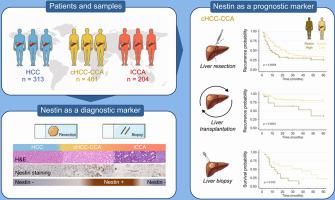Journal of Hepatology ( IF 26.8 ) Pub Date : 2022-08-18 , DOI: 10.1016/j.jhep.2022.07.019 Julien Calderaro 1 , Luca Di Tommaso 2 , Pascale Maillé 3 , Aurélie Beaufrère 4 , Cong Trung Nguyen 3 , Lara Heij 5 , Viviane Gnemmi 6 , Rondell P Graham 7 , Frédéric Charlotte 8 , Suzanne Chartier 9 , Dominique Wendum 9 , Mukul Vij 10 , Daniela Allende 11 , Alba Diaz 12 , Carla Fuster 12 , Benjamin Rivière 13 , Astrid Herrero 14 , Jérémy Augustin 3 , Katja Evert 15 , Diego Francesco Calvisi 15 , Wei Qiang Leow 16 , Howard Ho Wai Leung 17 , Jan Bednarsch 18 , Emmanuel Boleslawski 19 , Mohamed Rela 20 , Anthony Wing-Hung Chan 17 , Alejandro Forner 21 , Maria Reig 21 , Anaïs Pujals 3 , Loetitia Favre 3 , Manon Allaire 22 , Olivier Scatton 23 , Arnaud Uguen 24 , Eric Trépo 25 , Lukas Otero Sanchez 25 , Denis Chatelain 26 , Myriam Remmelink 27 , Camille Boulagnon-Rombi 28 , Céline Bazille 29 , Nathalie Sturm 30 , Benjamin Menahem 31 , Eric Frouin 32 , David Tougeron 33 , Christophe Tournigand 34 , Emmanuelle Kempf 34 , Haeryoung Kim 35 , Massih Ningarhari 36 , Sophie Michalak-Provost 37 , Jakob Nikolas Kather 38 , Annette S H Gouw 39 , Purva Gopal 40 , Raffaele Brustia 41 , Eric Vibert 42 , Kornelius Schulze 43 , Darius F Rüther 43 , Sören A Weidemann 44 , Rami Rhaiem 45 , Jean-Charles Nault 46 , Alexis Laurent 47 , Giuliana Amaddeo 48 , Hélène Regnault 49 , Eleonora de Martin 50 , Christine Sempoux 51 , Pooja Navale 52 , Jayendra Shinde 53 , Ketan Bacchuwar 53 , Maria Westerhoff 54 , Regina Cheuk-Lam Lo 55 , Mylène Sebbagh 56 , Catherine Guettier 56 , Marie Lequoy 57 , Mina Komuta 58 , Marianne Ziol 59 , Valérie Paradis 4 , Jeanne Shen 60 , Stefano Caruso 3

|
Background & Aims
Combined hepatocellular-cholangiocarcinoma (cHCC-CCA) is a rare primary liver cancer (PLC) associated with a poor prognosis. Given the challenges in its identification and its clinical implications, biomarkers are critically needed. We aimed to investigate the diagnostic and prognostic value of the immunohistochemical expression of Nestin, a progenitor cell marker, in a large multicentric series of PLCs.
Methods
We collected 461 cHCC-CCA samples from 32 different clinical centers. Control cases included 368 hepatocellular carcinomas (HCCs) and 221 intrahepatic cholangiocarcinomas (iCCAs). Nestin immunohistochemistry was performed on whole tumor sections. Diagnostic and prognostic performances of Nestin expression were determined using receiver-operating characteristic curves and Cox regression modeling.
Results
Nestin was able to distinguish cHCC-CCA from HCC with AUCs of 0.85 and 0.86 on surgical and biopsy samples, respectively. Performance was lower for the distinction of cHCC-CCA from iCCA (AUCs of 0.59 and 0.60). Nestin, however, showed a high prognostic value, allowing identification of the subset of cHCC-CCA (“Nestin High”, >30% neoplastic cells with positive staining) associated with the worst clinical outcome (shorter disease-free and overall survival) after surgical resection and liver transplantation, as well as when assessment was performed on biopsies.
Conclusion
We show in different clinical settings that Nestin has diagnostic value and that it is a useful biomarker to identify the subset of cHCC-CCA associated with the worst clinical outcome. Nestin immunohistochemistry may be used to refine risk stratification and improve treatment allocation for patients with this highly aggressive malignancy.
Lay summary
There are different types of primary liver cancers (i.e. cancers that originate in the liver). Accurately identifying a specific subtype of primary liver cancer (and determining its associated prognosis) is important as it can have a major impact on treatment allocation. Herein, we show that a protein called Nestin could be used to refine risk stratification and improve treatment allocation for patients with combined hepatocellular carcinoma, a rare but highly aggressive subtype of primary liver cancer.
中文翻译:

巢蛋白作为联合肝细胞胆管癌的诊断和预后标志物
背景与目标
联合肝细胞胆管癌 (cHCC-CCA) 是一种罕见的原发性肝癌 (PLC),预后较差。鉴于其识别及其临床意义的挑战,迫切需要生物标志物。我们旨在研究 Nestin(一种祖细胞标记物)在大型多中心系列 PLC 中的免疫组织化学表达的诊断和预后价值。
方法
我们从 32 个不同的临床中心收集了 461 个 cHCC-CCA 样本。对照病例包括 368 例肝细胞癌 (HCC) 和 221 例肝内胆管癌 (iCCA)。对整个肿瘤切片进行巢蛋白免疫组织化学。使用接受者操作特征曲线和 Cox 回归模型确定 Nestin 表达的诊断和预后性能。
结果
Nestin 能够区分 cHCC-CCA 和 HCC,手术和活检样本的 AUC 分别为 0.85 和 0.86。cHCC-CCA 与 iCCA 的区分性能较低(AUC 分别为 0.59 和 0.60)。然而,Nestin 显示出很高的预后价值,允许鉴定 cHCC-CCA 的子集(“Nestin 高”,>30% 的肿瘤细胞具有阳性染色)与最差的临床结果(更短的无病生存和总生存)手术切除和肝移植,以及何时对活检进行评估。
结论
我们在不同的临床环境中表明,巢蛋白具有诊断价值,并且它是一种有用的生物标志物,可用于识别与最差临床结果相关的 cHCC-CCA 子集。巢蛋白免疫组织化学可用于改进风险分层并改善患有这种高度侵袭性恶性肿瘤的患者的治疗分配。
外行总结
有不同类型的原发性肝癌(即起源于肝脏的癌症)。准确识别原发性肝癌的特定亚型(并确定其相关预后)很重要,因为它会对治疗分配产生重大影响。在此,我们展示了一种名为 Nestin 的蛋白质可用于改进风险分层并改善合并肝细胞癌患者的治疗分配,这是一种罕见但高度侵袭性的原发性肝癌亚型。











































 京公网安备 11010802027423号
京公网安备 11010802027423号